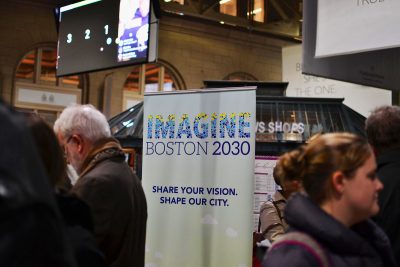
By Sophia Brown and Till Kaeslin
Boston residents and city officials participating in the Imagine Boston 2030 initiative met on Thursday afternoon at the Amtrak South Station for a round trip ride on the Fairmount Line.
The excursion involved a question and answer session in which citizens were given the opportunity to talk over ideas regarding the Imagine Boston initiative, Boston Mayor Martin Walsh’s plan for the future of the city.
The group examined Boston’s job growth, housing growth and overall transportation connectivity, with a special focus on Fairmount.
Natalia Urtubey, the director of engagement for Imagine Boston 2030, told the Daily Free Press these were important areas of concern in relation to Boston’s increasing population.
“Boston in the last four years has grown at twice the national average,” Urtubey said. “So as we are experiencing that growth, we have to be proactive in how we approach it.”
Urtubey said she predicts there will be an increase in jobs with the population growth, and emphasized the need to decide on where these jobs will be established.
“With that housing growth and population growth also comes job growth and job creation and innovation centers,” Urtubey said. “We have to be thoughtful about where we want those things to go.”
The housing market is currently under a lot of pressure, according to Urtubey.
“One of the things that we’ve talked about is housing and those new residents,” Urtubey said. “How do we accommodate 53,000 new units of housing by 2030?”
With housing development on the rise and housing stock remaining unchanged, housing prices are predicted to increase, according to Rebekah Emanuel, executive director of Imagine Boston 2030.
“Our median household income is the same approximately, but our household costs are 2.6 times as high,” Emanuel said. “Step number one is making sure we bring online more housing to accommodate more demand because we don’t see the demand slowing.”
Emanuel said this problem will continue as people start choosing more affordable housing options in the city.
“If we keep building, we become more affordable, and the more affordable we are, the more people want to live in Boston,” Emanuel said. “Step number two is really to figure out how to make sure that we can sort of contain the types of housing and make sure that things are affordable.”
To address concerns regarding the rising cost of housing, the Imagine Boston 2030 includes a new anti-displacement policy package, according to Emanuel.
“We’re hoping that that’s just the tip of the iceberg on a whole new range of policies that will be coming to light,” Emanuel said.
Attendees also voiced their complaints about the transportation between Fairmount and the city. They said the commuter rail does not run very efficiently or make enough stops to adequately serve everyone in the Fairmount area, while bottlenecked roads cause congestion for those with cars, making it difficult for commuters to get to their Boston-based jobs on time.
Sherry Flashman, 67, of Brookline, is involved in a number of collaborative community groups in the Fairmount area. She said several of Fairmount’s problems come from its geographical isolation from central Boston.
“I’d like to see the city working with the MBTA to turn this line into a rapid transit line and meet transportation needs,” Flashman said. “More rapid transit means more economic growth, more access to jobs, and more job growth.”




















































































































